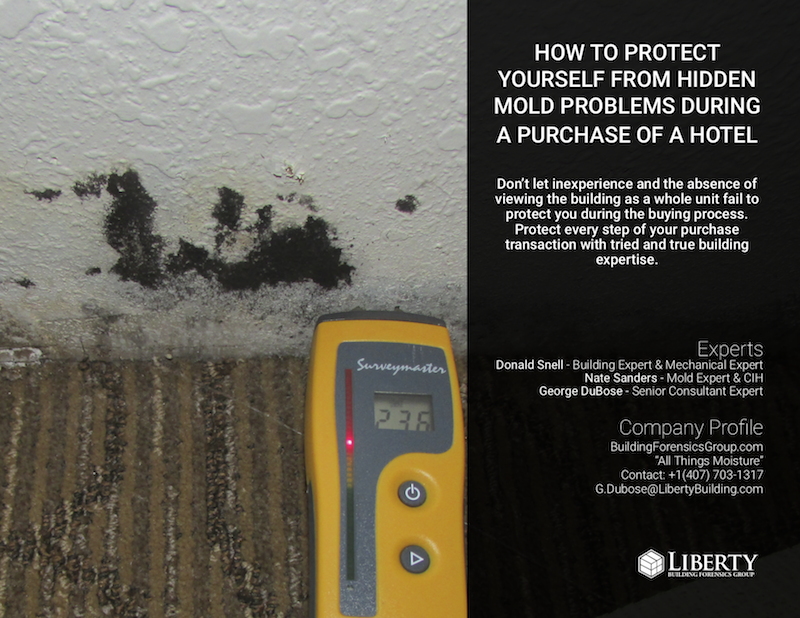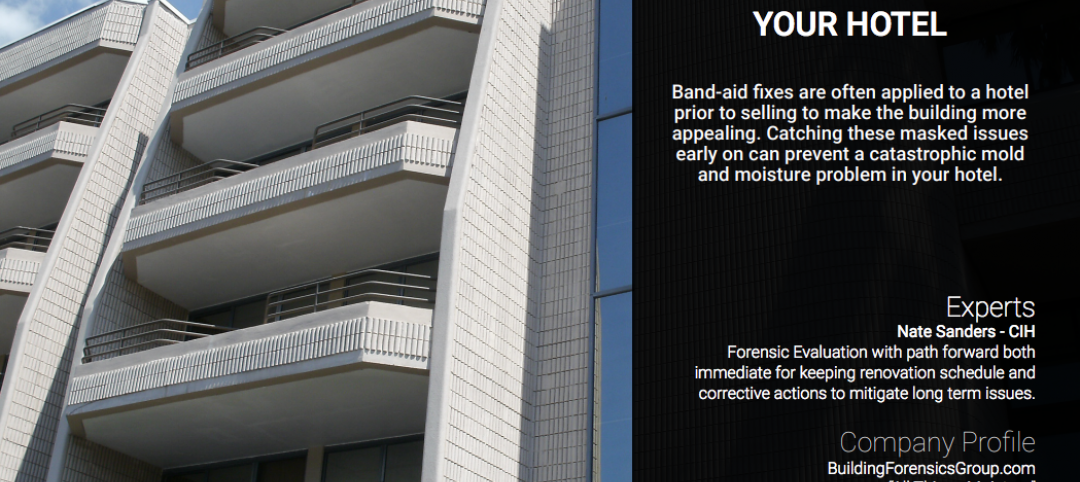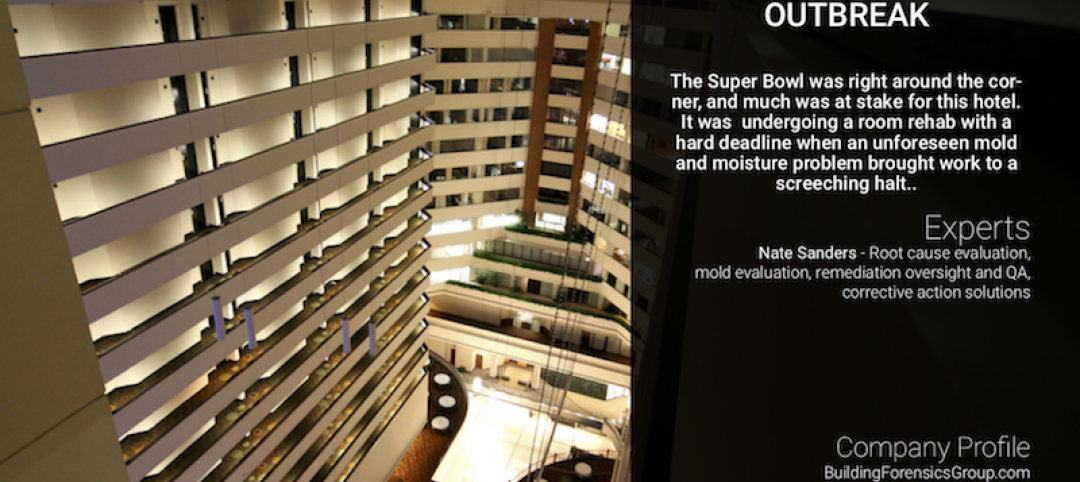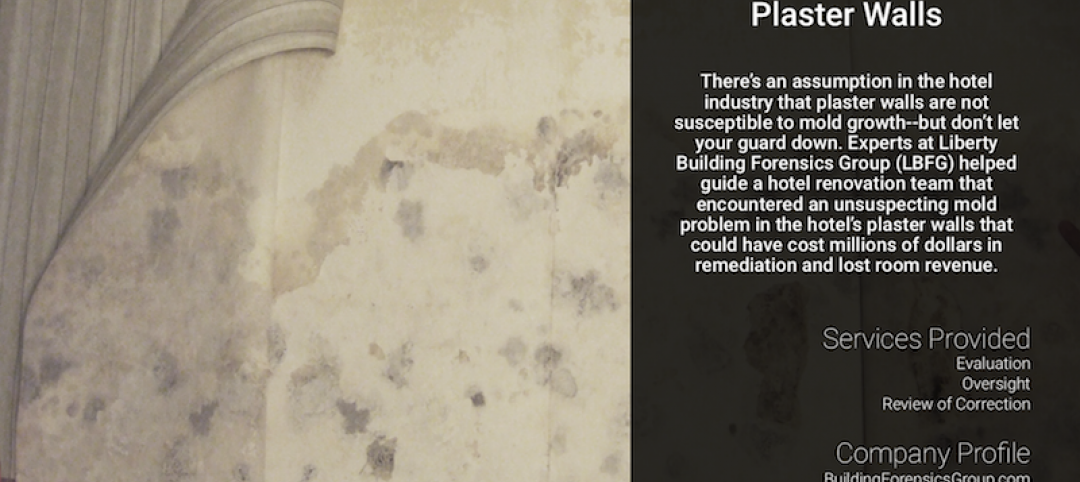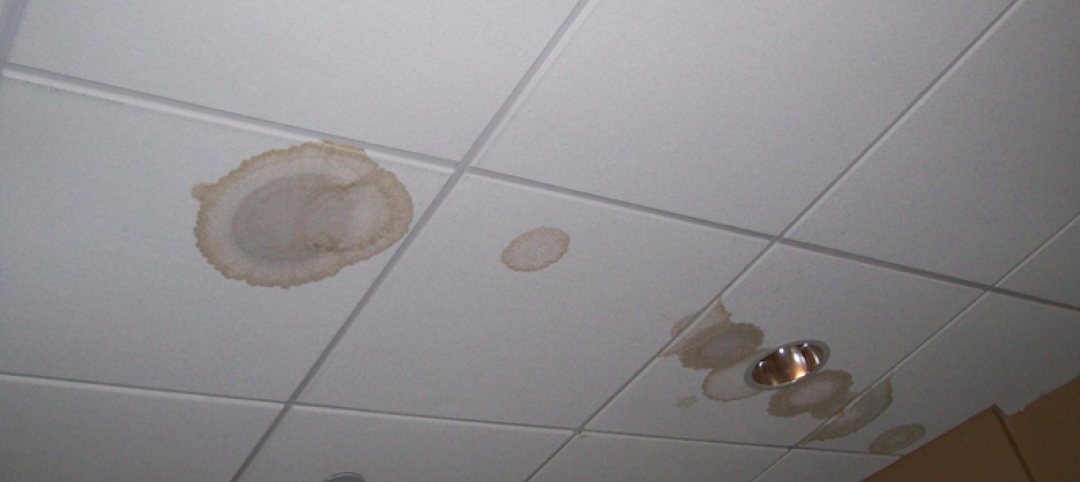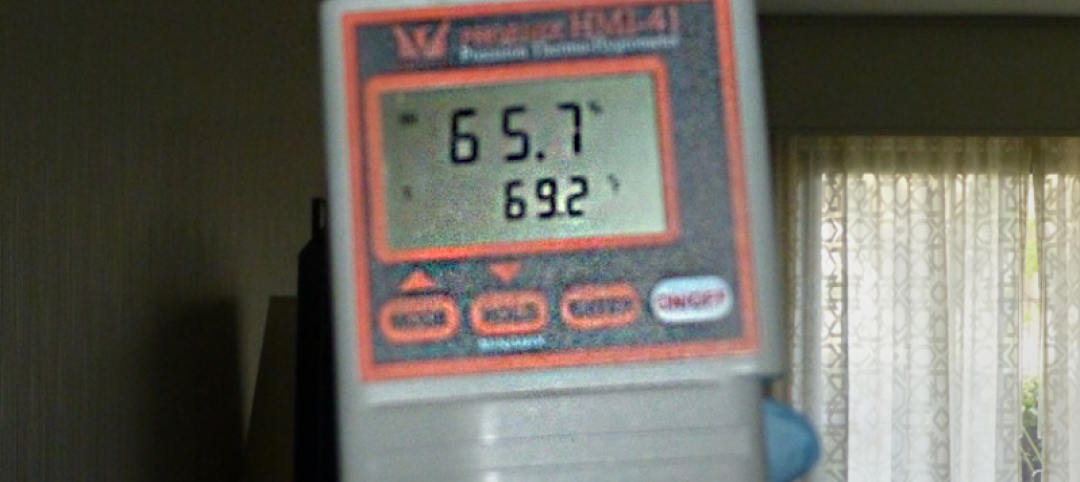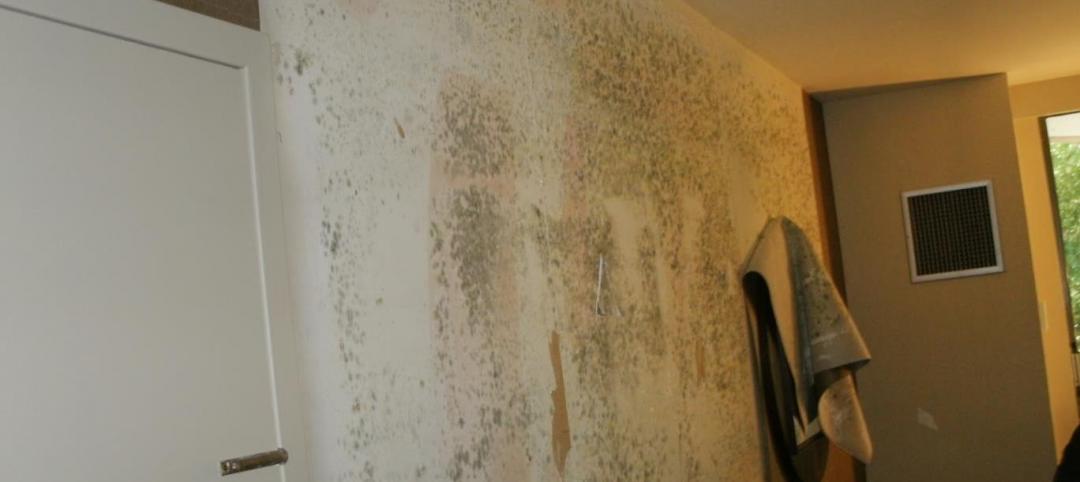Most prospective owners involved in the process of acquiring a hotel property understand that some renovations may be necessary, but aren’t prepared for hidden moisture and mold damage that will exponentially escalate repair costs. Unfortunately, this kind of oversight happens repeatedly during hotel transactions because the due process that is followed doesn’t include the interaction of building systems that actually cause moisture and mold damage. This common industry mishap causes many new owners to make a wrongful assump- tion during their purchase, potentially costing them millions of dollars in unplanned renovations and room outage costs.
When it comes to uncovering hidden mold, significant gaps exist in the due diligence process leading up to a hotel transaction, increasing the purchaser’s risk.
A typical hotel transaction process includes a property condition assessment (PCA) and can also include a Phase 1 Environmental Report. Unbeknownst to most, significant gaps occur in the process because, while these assessments usually identify the existence of damage, they never identify the extent, cause, or cost to recover the damage.
Buyers negotiate the purchase price for a hotel based on the information available from the PCA and Phase 1 Environmental Report, but often fall short because these assess- ments do not cover the true extent of the damage. As a result, many new owners acquire a property that requires significantly more money than expected to remediate the hidden damage, in addition to taking on the costs associated with extended room outages. They are left with the choice to either pay for the extra remediation costs out of pocket, or else file a claim with the insurance company in the hope of recovering the cost after the sale.
 Evidence of a moisture problem that existed prior to hotel purchase.
Evidence of a moisture problem that existed prior to hotel purchase.
HOW TO PLUG THE HOLES IN THE TRANSACTION PROCESS
An investment group purchased a high-rise guest tower hotel in the Southeast United States. The hotel was over 30 years old, and its major equipment was in the run-to-failure mode. The PCA identified the major building systems and their remaining useful life. The Phase 1 Environmental Report identified (on the surface, through non-destructive test- ing) that there was some physical damage in the form of moisture and mold.
The hotel transaction process is very prescriptive in regards to the PCA; an ASTM stan- dard for the PCA requires it to identify and communicate physical deficiencies of the prop- erty. However, it does not uncover any failures that have occurred due to the interaction between the HVAC and building envelope systems, nor does it recommend how to fix them other than equipment replacement. Replac- ing equipment is not always the best solution because this strategy doesn’t address the cause of the deficiency, which means the same issues will likely recur again. This widespread industry problem has reared its head for decades and needs to be brought to light and addressed.
In this particular case, because the equipment and systems were in the run-to-failure mode, surface damage was masking more wide- spread damage. The evident damage was just the tip of the iceberg; the full extent of damage as well as its underlying causes were never detected.
The new owners hired the same company that had performed the Phase 1 Environmental Report to conduct a more extensive investiga- tion of the problem in an attempt to pinpoint the cause and provide solutions. After this company performed their additional (and expen- sive) investigation, they provided the owners with a list of symptoms determined by taking the hotel’s vital signs. As an environmental firm, they specialized in taking readings and measurements of the rooms, which con- firmed the damage but didn’t provide the owner with the cause or, more importantly, the solution. Thus, after this additional assessment, the owners were still left with unanswered questions, and with little direction about what to do next.
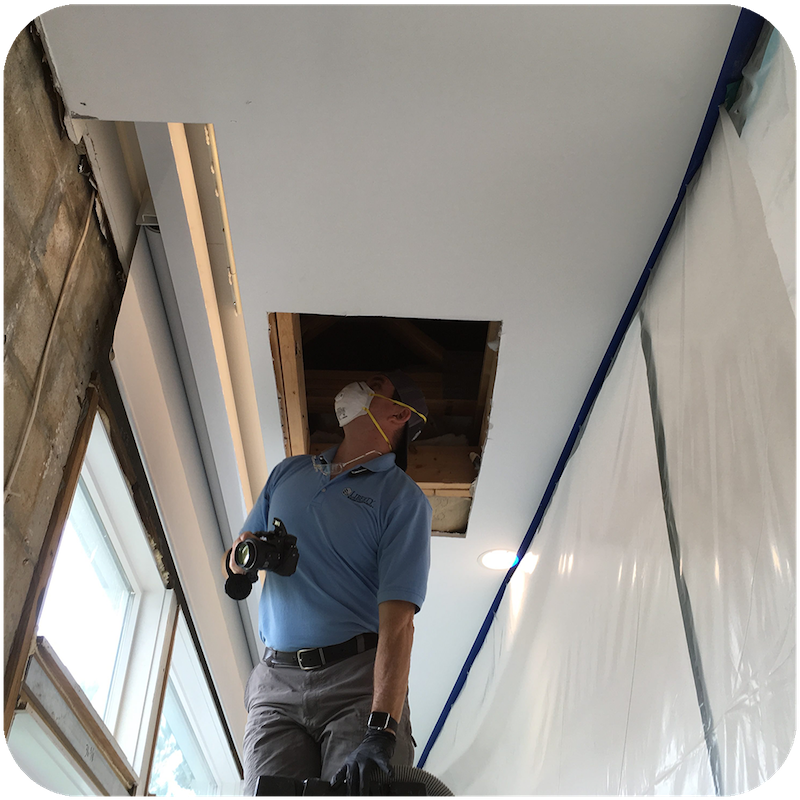 Mold damage due to the absence of supply air above the top-floor ceiling in areas where the designed thermal and air barriers were on the underside of the roof.
Mold damage due to the absence of supply air above the top-floor ceiling in areas where the designed thermal and air barriers were on the underside of the roof.
Once Liberty was retained to investigate, we were able to bring the multi-disciplinary resources required to solve complex mold and moisture problems similar to the condi- tions found in their hotel. Our extensive experience in hot and humid climates, as well as our intimate knowledge of the interactions between the building envelope and HVAC systems, allowed us to not only strategize a work plan and method statements that confirmed the defects leading to the failures, but also to identify the extent of damage to help support cost recovery after the sale.
SOLVE + FIX = PREVENT RECURRENCE
f remediation efforts are not methodically planned and executed, the consequential effects of these types of failures can drive costs up into the seven-figure range. Our client’s two most important objectives were coincidentally our two biggest challenges. Our first task was to identify the root cause of the issue and strategize a solution that would FIX and SOLVE the existing problem efficiently and PREVENT it from recurring. Every day that went by with unoccupied rooms was compounding lost revenue for our client, so the pressure to get these rooms ready for occupants was severe. Secondly, our client’s goal was to MAXIMIZE their insurance recovery after the sale. Since the prior assessments didn’t identify the full extent of damage, the discount negotiated in the purchase price wasn’t enough to help offset the needed repairs.
SOLUTIONS REQUIRED BOTH FACADE AND HVAC FIXES
Our multidisciplinary team of mold assessors, HVAC experts, and building envelope experts was able to identify the complete extent of de- fects that led to the failures, allowing them to SOLVE, FIX, and RECOVER the building’s mold and moisture problems and PREVENT future ones. They determined that a number of the major systems and equipment in run-to-failure mode were far beyond their service life. Addi- tionally, the watertight integrity of the facade had been compromised, resulting in widespread hidden moisture damage on exterior walls.
The following defects contributed to causing the damage: negative pressure by the HVAC; a leaky building envelope; inadequately dehu- midified make-up air that did not effectively reach guest rooms; inadequately sealed chilled water pipe insulation transverse and longitudi- nal joints; and the absence of supply air above the top ceiling in areas where the designed thermal and air barriers were on the underside of the roof. None of these major issues had been uncovered by the PCA or the Phase 1 Environmental Report. Had our client known about these issues prior to purchasing the hotel, they would have negotiated a better price to offset repairs.
Our client now realized that the systems and procedures in place to supposedly pro- tect their investment during a hotel transaction had in fact failed them. Their goal had been to incorporate the cost of renovations into the transaction, but because the new owners had already exceeded that amount, they were going to attempt to self-fund the repairs. Since the necessary repairs had been grossly underestimated, the cost contin- ued to escalate far beyond their insurance policy deductible and they needed guidance to maximize their insurance recovery.
Understanding the interaction between the building envelope and HVAC system, Liberty experts were able to diagnose the failures and determine a solution for recovery. The proposed solutions were provided in a matrix form, offering “good,” “better,” or “best” options that all met the dehumidification requirements for the space but allowed the client to make the best business decision that aligned with their goals for the property. For example, provided options to minimize conditions conducive to negative pressure within the guest rooms ranged from installing constant flow regulators in the rooms, to converting the continuous exhaust system to a non-continuous exhaust system.
An additional challenge was that the hotel had to remain operational during remedia- tion. Very rarely do hotels shut down because of moisture and mold. The remediation approach had to address the mold while simultaneously making repairs to major me- chanical equipment without inconveniencing the hotel guest. For example, the vapor retarder on the insulation of some chilled water lines was damaged beyond repair.
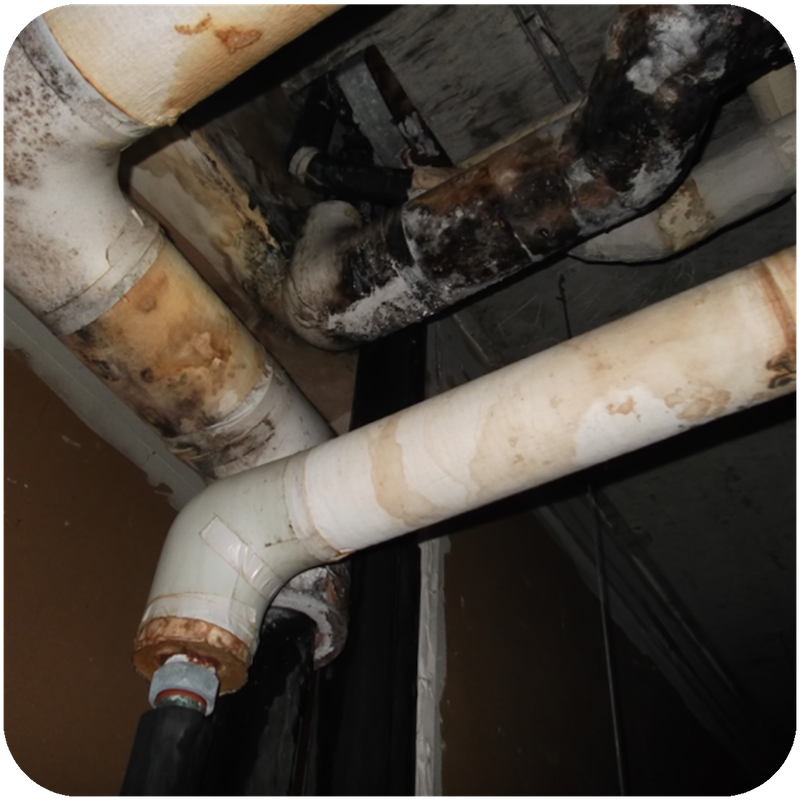 Hidden mold can impact walls as well as buildings.
Hidden mold can impact walls as well as buildings.
The working sequence during replacement was very important, and condensation had to be controlled to prevent further mold growth. There were very specific requirements for both the type of insulation to be used as well as the types of mastics and sealants that were conducive to the environment in which this work had to be done.
HIDDEN MOLD = HIDDEN COSTS
The buyer’s primary goals were to maximize recovery costs, minimize room outages, and get rooms operational again in a short amount of time. They worked with Liberty and their insurance company to maximize recovery, going off a set of options to mitigate the problem using information provided to them in the initial assessments.
Through the process, they gained a heightened awareness of the patent and zombie defects that did not rise to a level of concern during the initial assessment phase. The remediation project was successfully moved along to get the rooms operational quickly and help maxi- mize the new owner’s insurance recovery.
Liberty Building Forensics Group is committed to SOLVE. FIX. PREVENT. RECOVER the world’s most complex building mold and moisture failures. Our firm has project experience in the U.S., Canada, Mexico, the Caribbean, Central America, the Middle East, Southeast Asia, and Europe. Contact us at g.dubose@libertybuilding.com or by phone at 407/467-5518 or visit us at http://www.buildingforensicsgroup.com/.
More from Author
Richard Scott-AIA, NCARB, LEED AP of Liberty Building Forensics Group | Feb 7, 2019
Don't let a simple band-aid fix cause a mold problem in your hotel
Band-aid fixes are often applied to a hotel prior to selling to make the building more appealing. Catching these masked issues early on can prevent a catastrophic mold and moisture problem in your hotel.
Richard Scott-AIA, NCARB, LEED AP of Liberty Building Forensics Group | Jan 28, 2019
Hotel renovation for the Super Bowl halted due to mold outbreak
The Super Bowl was right around the corner, and much was at stake for this hotel. It was undergoing a room rehab with a hard deadline when an unforeseen mold and moisture problem brought work to a screeching halt.
Richard Scott-AIA, NCARB, LEED AP of Liberty Building Forensics Group | Jan 21, 2019
Hotel renovation threatened due to unexpected mold on plaster walls
Mold growth is not seen as frequently on plaster walls as it is on gypsum wallboard, primarily because there are no nutrients to support mold growth.
Richard Scott-AIA, NCARB, LEED AP of Liberty Building Forensics Group | Jan 14, 2019
Air barriers: Expectations vs. reality
When new building code requirements require high performance and innovation incentives, such as those found in green building rating systems, significant confusion and some building failure will ensue.
Richard Scott-AIA, NCARB, LEED AP of Liberty Building Forensics Group | Nov 20, 2018
Monitor these 9 vital signs to avoid widespread mold & moisture problems in your building
Many building owners and operators rely solely on a property condition assessment (PCA) to determine if they have a problem.
Richard Scott-AIA, NCARB, LEED AP of Liberty Building Forensics Group | Jul 13, 2018
Hotel renovation: More than just minding the dust
Do you know the vital signs for avoiding moisture & mold problems? Will your brand standards cause you headaches? How will you recover costs if you do get into trouble?

